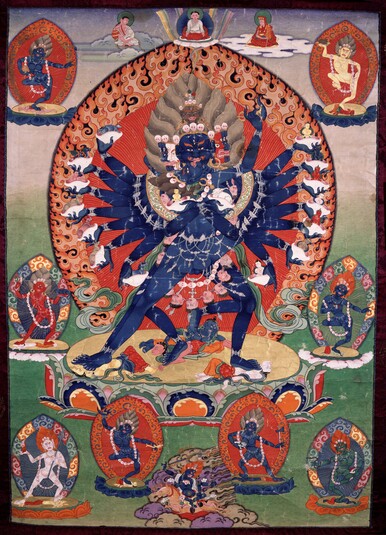
Item: Hevajra (Buddhist Deity)
| Origin Location | Eastern Tibet |
|---|---|
| Date Range | 1800 - 1899 |
| Lineages | Kagyu and Buddhist |
| Size | 58.42x41.28cm (23x16.25in) |
| Material | Ground Mineral Pigment, Fine Gold Line on Cotton |
| Collection | Rubin Museum of Art |
| Catalogue # | acc.# F1998.1.7 |
| Painting School | Palpung / Situ |
Classification: Deity
Shri Hevajra with Nine-deities (Tibetan: pal gye pa dor je lha gu) the tutelary deity of Marpa the Translator, founder of the Kagyu School.
Sanskrit: Hevajra Tibetan: Gye pa dor je
Tibetan: Gye pa dor je
Semi-wrathful, dark blue in colour with eight faces, sixteen hands and four legs, at each side of the main face are three further faces with the eighth situated centrally above. Brown hair flows upward like flame from each of the heads. Skullcups are held in sixteen hands. The eight on the right hold various animals looking inward and the eight on the left hold the eight worldly gods gazing outward. The first pair of arms folded at the heart embrace the consort. Adorned with a crown of five skulls, bone ornaments and a necklace of fifty freshly severed heads he has the appearance of being slightly wrathful and slightly peaceful. The consort Vajra Nairatmya, blue in colour, has one face and two hands. In the upraised right she holds a curved knife. Adorned with a tiara of five skulls, a necklace of fifty skulls and white bone ornaments, she is supported by the left leg with the right embracing Hevajra. Standing on two legs with the two remaining drawn up in a dancing stance atop the forms of four Hindu gods, a sun disc and multi-coloured lotus seat, Hevajra and consort are completely surrounded by the flames of pristine awareness.
Encircling Hevajra are the 8 goddesses of the retinue. At the upper right and left are blue Candali and yellow Vetali. At the lower middle are red Cauri and blue Dombini. At the lower left are white Shavari and blue-black Gauri. At the lower right are blue Pukkasi and green Ghasmari. They each have one face and two hands holding various objects, adorned with bone ornaments, a necklace of fifty skulls and stand above a corpse, sun disc and lotus seat.
At the top center is Marpa the Translator, with both hands extended over the knees performing the 'earth witness' mudra (gesture); attired in the garments of a layman. At the left is the famous Tibetan yogi Milarepa with the right hand cupped to the ear and the left holding a skullcup in the lap; wearing a white cotton robe and red meditation belt, seated in a relaxed posture. At the right is the lama Gampopa with the hands folded in the lap in the mudra of meditation; wearing the robes of a monk and a red cap.
At the bottom center is the wrathful protector Shri Devi Mahakali (Tib.: pal den lha mo), dark blue in colour with one face and four hands. In the first right and left hands are a skullcup and trident and in the second pair an upraised sword in the right hand and a lance extended outward with the left. She rides atop a brown mule surrounded by purple-grey smoke.
According to the Kagyu system of tantra classification Shri Hevajra belongs to the 'Wisdom-mother' Anuttarayoga tantra. From the various forms of Hevajra this figure is known as the 'Essence Hevajra' as taught in the root Tantra of 'Two Sections.'
Distant Indian Lineage: Vajradhara, Jnana Dakini, Bodhivajra Garbha, Arya Nagarjuna, Aryadeva, Candrakirti, Matangipa, Tailo Prajnabhadra, Naro Jnana Siddhi, Marpa Lotsawa Chokyi Lodro, etc.
Jeff Watt 4-98
Tradition: Kagyu Deity Paintings
Collection of Rubin Museum of Art: Painting Gallery 3
Buddhist Deity: Hevajra Main Page
Tradition: Drigung Kagyu Main Page
Tradition: Taglung Kagyu Main Page
Tradition: Drugpa Kagyu Main Page
Buddhist Deity: Hevajra, Deity Paintings
Collection of Rubin Museum: Hevajra
Subject: Protectors - Wrathful Deities that are not Protectors
Buddhist Deity: Hevajra (Best Examples, Painting)


